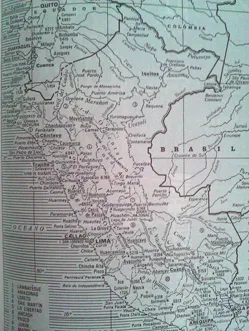(Continuation from “Living the Peruvian Experience: The Beginning,” in All Peruvians play folk near Metro Centrum!)
To our initial question, “are Peruvians identical in the eyes of Polish people?”, the answer is in reality NO. Certainly, for many people in Poland all Peruvians are still the same, but at least we can be sure that there are today less people who think so than there were six months ago. Hence, let us not only cheer upon that, but let this article have its contribution, too.
Machu Picchu, the Incas, the llamas, the Andean folk music, and the panpipes are not reflecting a mistaken image of Peru. The mistake comes when we assume that they represent Peru as a whole. If we look at them carefully we will realize that what they all have in common is the fact that they generally represent only ONE region of Peru: the Andean mountains. So, let us see if Peru is all about the Andean mountains.
Peru is geographically diverse
If we know little to nothing about Peru, and for some unconventional reason we may be stroke by a tiny spark of curiosity, an incredibly easy way to get started on the topic of Peru could be by taking the following steps: first, let us open our Internet browser; then, let us find a geographical map of Peru on Google; and, finally, let us have a look at what this map relates. Usually, Peru is shown divided into four different colors: blue for the Pacific Ocean, yellow for the desert coast, brown for the Andean mountains, and green for the Amazon rainforest. Judging by colors only we could figure out in less than 30 seconds that Peru may actually be geographically diverse, and not just made out of a mountain chain. In this way, we have managed to cross the boundaries the majority of people on Earth still have not. What comes next is basically placing anything we could think of on the map, using a little bit of logic, imagination, and a little bit more of curiosity.
The most conventional item representing Peru is Machu Picchu. If we browsed such terms on the Internet the first thing we will come across will probably be photographs of a green mountain with gigantic rocks. When we try to locate it on our map, we will realize that it is such an insignificant dot that there is so much space left in it: indeed, Peru is big! Thus, we can logically conclude two things: that Machu Picchu does not occupy the whole Peru but only a minor proportion of it, and that there is no way that such a great edification is the only touristic site in the whole country. Deepening in the former argument and researching a little bit more, Machu Picchu occupies a territory of 530 meters of length times 200 meters of width, and is located in the heart of Peru, the 20th biggest country in the world with an area of 1.285.215 km2. Thus, Peru is neither fully occupied by Machu Picchu nor do Peruvians live in magnificent fortresses of that kind.
How about other sites?
There are thousands of sites as important and splendid as Machu Picchu along and away from the Andes. Among others, some of the most representative are the largest Pre-Columbian city in South America – Chan Chan, the Nazca lines, the Paracas National Reservation, the Moche archaeological site of Sipan, and the fantastic Northern-beach circuit, on the coast; the Chavín de Huántar archaeological site, the Inca archaeological sites of Ollantaytambo and Sacsayhuamán, the Inca Empire’s capital city – Cusco, and the highest commercially navigable lake in the world – Titicaca, on the mountains; the Kuelap fortress, the Pacaya Samiria National Reserve, the Amazon River, the Manú National Park, and the Tambopata-Candamo National Reserve, in the rainforest. So, when planning our next trip to Peru, let us make sure that we not only look at Machu Picchu but at the great variety of sites Peru hast to offer.
to be continued
Luis Escobedo













